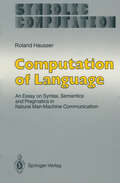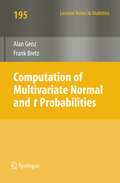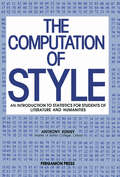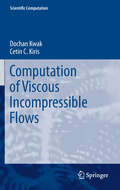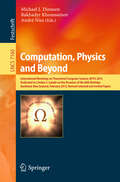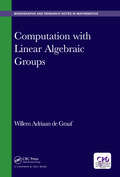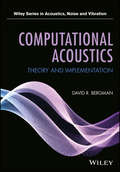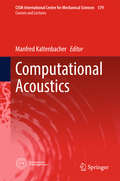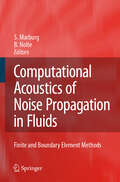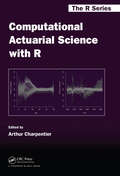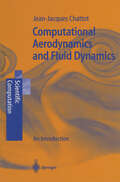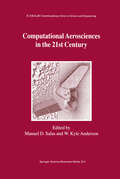- Table View
- List View
Computation of Language: An Essay on Syntax, Semantics and Pragmatics in Natural Man-Machine Communication (Symbolic Computation)
by Roland HausserThe study of linguistics has been forever changed by the advent of the computer. Not only does the machine permit the processing of enormous quantities of text thereby securing a better empirical foundation for conclusions-but also, since it is a modelling device, the machine allows the implementation of theories of grammar and other kinds of language processing. Models can have very unexpected properties both good and bad-and it is only through extensive tests that the value of a model can be properly assessed. The computer revolution has been going on for many years, and its importance for linguistics was recognized early on, but the more recent spread of personal workstations has made it a reality that can no longer be ignored by anyone in the subject. The present essay, in particular, could never have been written without the aid of the computer. I know personally from conversations and consultations with the author over many months how the book has changed. If he did not have at his command a powerful typesetting program, he would not have been able to see how his writing looked and exactly how it had to be revised and amplified. Even more significant for the evolution of the linguistic theory is the easy testing of examples made possible by the implementation of the parser and the computer-held lexicon. Indeed, the rule set and lexicon grew substantially after the successes of the early implementations created the desire to incorporate more linguistic phenomena.
Computation of Multivariate Normal and t Probabilities (Lecture Notes in Statistics #195)
by Alan Genz Frank BretzMultivariate normal and t probabilities are needed for statistical inference in many applications. Modern statistical computation packages provide functions for the computation of these probabilities for problems with one or two variables. This book describes recently developed methods for accurate and efficient computation of the required probability values for problems with two or more variables. The book discusses methods for specialized problems as well as methods for general problems. The book includes examples that illustrate the probability computations for a variety of applications.
The Computation of Style: An Introduction to Statistics for Students of Literature and Humanities
by Anthony KennyEach year more and more scholars are becoming aware of the importance of the statistical study of literary texts. The present book is the first elementary introduction in English for those wishing to use statistical techniques in the study of literature. Unlike other introductions to statistics, it specifically emphasizes those techniques most useful in literary contexts and gives examples of their application from literary and linguistic material. The text is aimed at those with the minimum of mathematical background and gives exercises for the student and relevant statistical tables.
Computation of Viscous Incompressible Flows (Scientific Computation)
by Dochan Kwak Cetin C. KirisThis monograph is intended as a concise and self-contained guide to practitioners and graduate students for applying approaches in computational fluid dynamics (CFD) to real-world problems that require a quantification of viscous incompressible flows. In various projects related to NASA missions, the authors have gained CFD expertise over many years by developing and utilizing tools especially related to viscous incompressible flows. They are looking at CFD from an engineering perspective, which is especially useful when working on real-world applications. From that point of view, CFD requires two major elements, namely methods/algorithm and engineering/physical modeling. As for the methods, CFD research has been performed with great successes. In terms of modeling/simulation, mission applications require a deeper understanding of CFD and flow physics, which has only been debated in technical conferences and to a limited scope. This monograph fills the gap by offering in-depth examples for students and engineers to get useful information on CFD for their activities. The procedural details are given with respect to particular tasks from the authors’ field of research, for example simulations of liquid propellant rocket engine subsystems, turbo-pumps and the blood circulations in the human brain as well as the design of artificial heart devices. However, those examples serve as illustrations of computational and physical challenges relevant to many other fields. Unlike other books on incompressible flow simulations, no abstract mathematics are used in this book. Assuming some basic CFD knowledge, readers can easily transfer the insights gained from specific CFD applications in engineering to their area of interest.
Computation, Physics and Beyond: International Workshop on Theoretical Computer Science, WTCS 2012, Dedicated to Cristian S. Calude on the Occasion of His 60th Birthday, Auckland, New Zealand, February 21-24, 2012, Revised Selected and Invited Papers (Lecture Notes in Computer Science #7160)
by Michael J. Dinneen Bakhadyr Khoussainov Prof. Andre NiesThis Festschrift volume has been published in honor of Cristian Calude on the occasion of his 60th birthday and contains contributions from invited speakers and regular papers presented at the International Workshop on Theoretical Computer Science, WTCS 2012, held in Auckland, New Zealand, in February 2012. Cristian Calude has made a significant contribution to research in computer science theory. Along with early work by Chaitin, Kučera, Kurtz, Solovay, and Terwijn his papers published in the mid-1990s jointly with Khoussainov, Hertling, and Wang laid the foundation for the development of modern theory of algorithmic randomness. His work was essential for establishing the leading role of New Zealand in this area. The research interests of Cristian Calude are reflected in the topics covered by the 32 papers included in this book, namely: algorithmic information theory, algorithms, automata and formal languages, computing and natural sciences, computability and applications, logic and applications, philosophy of computation, physics and computation, and unconventional models of computation. They have been organized into four parts. The first part consists of papers discussing his life achievements. This is followed by papers in the three general areas of complexity, computability, and randomness; physics, philosophy (and logic), and computation; and algorithms, automata, and formal models (including unconventional computing).
Computation with Linear Algebraic Groups (Chapman & Hall/CRC Monographs and Research Notes in Mathematics)
by Willem Adriaan de GraafDesigned as a self-contained account of a number of key algorithmic problems and their solutions for linear algebraic groups, this book combines in one single text both an introduction to the basic theory of linear algebraic groups and a substantial collection of useful algorithms. Computation with Linear Algebraic Groups offers an invaluable guide to graduate students and researchers working in algebraic groups, computational algebraic geometry, and computational group theory, as well as those looking for a concise introduction to the theory of linear algebraic groups.
Computation with Linear Algebraic Groups (Chapman & Hall/CRC Monographs and Research Notes in Mathematics)
by Willem Adriaan de GraafDesigned as a self-contained account of a number of key algorithmic problems and their solutions for linear algebraic groups, this book combines in one single text both an introduction to the basic theory of linear algebraic groups and a substantial collection of useful algorithms. Computation with Linear Algebraic Groups offers an invaluable guide to graduate students and researchers working in algebraic groups, computational algebraic geometry, and computational group theory, as well as those looking for a concise introduction to the theory of linear algebraic groups.
Computational Acoustics: Theory and Implementation (Wiley Series in Acoustics Noise and Vibration)
by David R. BergmanCovers the theory and practice of innovative new approaches to modelling acoustic propagation There are as many types of acoustic phenomena as there are media, from longitudinal pressure waves in a fluid to S and P waves in seismology. This text focuses on the application of computational methods to the fields of linear acoustics. Techniques for solving the linear wave equation in homogeneous medium are explored in depth, as are techniques for modelling wave propagation in inhomogeneous and anisotropic fluid medium from a source and scattering from objects. Written for both students and working engineers, this book features a unique pedagogical approach to acquainting readers with innovative numerical methods for developing computational procedures for solving problems in acoustics and for understanding linear acoustic propagation and scattering. Chapters follow a consistent format, beginning with a presentation of modelling paradigms, followed by descriptions of numerical methods appropriate to each paradigm. Along the way important implementation issues are discussed and examples are provided, as are exercises and references to suggested readings. Classic methods and approaches are explored throughout, along with comments on modern advances and novel modeling approaches. Bridges the gap between theory and implementation, and features examples illustrating the use of the methods described Provides complete derivations and explanations of recent research trends in order to provide readers with a deep understanding of novel techniques and methods Features a systematic presentation appropriate for advanced students as well as working professionals References, suggested reading and fully worked problems are provided throughout An indispensable learning tool/reference that readers will find useful throughout their academic and professional careers, this book is both a supplemental text for graduate students in physics and engineering interested in acoustics and a valuable working resource for engineers in an array of industries, including defense, medicine, architecture, civil engineering, aerospace, biotech, and more.
Computational Acoustics: Theory and Implementation (Wiley Series in Acoustics Noise and Vibration)
by David R. BergmanCovers the theory and practice of innovative new approaches to modelling acoustic propagation There are as many types of acoustic phenomena as there are media, from longitudinal pressure waves in a fluid to S and P waves in seismology. This text focuses on the application of computational methods to the fields of linear acoustics. Techniques for solving the linear wave equation in homogeneous medium are explored in depth, as are techniques for modelling wave propagation in inhomogeneous and anisotropic fluid medium from a source and scattering from objects. Written for both students and working engineers, this book features a unique pedagogical approach to acquainting readers with innovative numerical methods for developing computational procedures for solving problems in acoustics and for understanding linear acoustic propagation and scattering. Chapters follow a consistent format, beginning with a presentation of modelling paradigms, followed by descriptions of numerical methods appropriate to each paradigm. Along the way important implementation issues are discussed and examples are provided, as are exercises and references to suggested readings. Classic methods and approaches are explored throughout, along with comments on modern advances and novel modeling approaches. Bridges the gap between theory and implementation, and features examples illustrating the use of the methods described Provides complete derivations and explanations of recent research trends in order to provide readers with a deep understanding of novel techniques and methods Features a systematic presentation appropriate for advanced students as well as working professionals References, suggested reading and fully worked problems are provided throughout An indispensable learning tool/reference that readers will find useful throughout their academic and professional careers, this book is both a supplemental text for graduate students in physics and engineering interested in acoustics and a valuable working resource for engineers in an array of industries, including defense, medicine, architecture, civil engineering, aerospace, biotech, and more.
Computational Acoustics (CISM International Centre for Mechanical Sciences #579)
by Manfred KaltenbacherThe book presents a state-of-art overview of numerical schemes efficiently solving the acoustic conservation equations (unknowns are acoustic pressure and particle velocity) and the acoustic wave equation (pressure of acoustic potential formulation). Thereby, the different equations model both vibrational- and flow-induced sound generation and its propagation. Latest numerical schemes as higher order finite elements, non-conforming grid techniques, discontinuous Galerkin approaches and boundary element methods are discussed. Main applications will be towards aerospace, rail and automotive industry as well as medical engineering. The team of authors are able to address these topics from the engineering as well as numerical points of view.
Computational Acoustics of Noise Propagation in Fluids - Finite and Boundary Element Methods
by Steffen Marburg Bodo NolteThe book provides a survey of numerical methods for acoustics, namely the finite element method (FEM) and the boundary element method (BEM). It is the first book summarizing FEM and BEM (and optimization) for acoustics. The book shows that both methods can be effectively used for many other cases, FEM even for open domains and BEM for closed ones. Emphasis of the book is put on numerical aspects and on treatment of the exterior problem in acoustics, i.e. noise radiation.
Computational Actuarial Science with R (Chapman And Hall/crc The R Ser. #17)
by Arthur CharpentierA Hands-On Approach to Understanding and Using Actuarial ModelsComputational Actuarial Science with R provides an introduction to the computational aspects of actuarial science. Using simple R code, the book helps you understand the algorithms involved in actuarial computations. It also covers more advanced topics, such as parallel computing and C/
Computational Actuarial Science with R
by Arthur CharpentierA Hands-On Approach to Understanding and Using Actuarial ModelsComputational Actuarial Science with R provides an introduction to the computational aspects of actuarial science. Using simple R code, the book helps you understand the algorithms involved in actuarial computations. It also covers more advanced topics, such as parallel computing and C/
Computational Aerodynamics and Fluid Dynamics: An Introduction (Scientific Computation)
by Jean-Jacques ChattotThe book gives the reader the basis for understanding the way numerical schemes achieve accurate and stable simulations of physical phenomena. It is based on the finite-difference method and simple problems that allow also the analytic solutions to be worked out. ODEs as well as hyperbolic, parabolic and elliptic types are treated. The book builds on simple model equations and, pedagogically, on a host of problems given together with their solutions.
Computational Aerosciences in the 21st Century: Proceedings of the ICASE/LaRC/NSF/ARO Workshop, conducted by the Institute for Computer Applications in Science and Engineering, NASA Langley Research Center, The National Science Foundation and the Army Research Office, April 22–24, 1998 (ICASE LaRC Interdisciplinary Series in Science and Engineering #8)
by Manuel D. Salas W. Kyle AndersonOver the last decade, the role of computational simulations in all aspects of aerospace design has steadily increased. However, despite the many advances, the time required for computations is far too long. This book examines new ideas and methodologies that may, in the next twenty years, revolutionize scientific computing. The book specifically looks at trends in algorithm research, human computer interface, network-based computing, surface modeling and grid generation and computer hardware and architecture. The book provides a good overview of the current state-of-the-art and provides guidelines for future research directions. The book is intended for computational scientists active in the field and program managers making strategic research decisions.
Computational Algebra
by Klaus G. FischerBased on the fifth Mid-Atlantic Algebra Conference held recently at George Mason University, Fairfax, Virginia. Focuses on both the practical and theoretical aspects of computational algebra. Demonstrates specific computer packages, including the use of CREP to study the representation of theory for finite dimensional algebras and Axiom to study algebras of finite rank.
Computational Algebra
by Klaus G. Fischer, Philippe Loustaunau, Jay Shapiro, Edward L. Green and Daniel FarkasBased on the fifth Mid-Atlantic Algebra Conference held recently at George Mason University, Fairfax, Virginia. Focuses on both the practical and theoretical aspects of computational algebra. Demonstrates specific computer packages, including the use of CREP to study the representation of theory for finite dimensional algebras and Axiom to study algebras of finite rank.
Computational Algebra and Number Theory (Mathematics and Its Applications #325)
by Wieb Bosma Alf Van Der PoortenComputers have stretched the limits of what is possible in mathematics. More: they have given rise to new fields of mathematical study; the analysis of new and traditional algorithms, the creation of new paradigms for implementing computational methods, the viewing of old techniques from a concrete algorithmic vantage point, to name but a few. Computational Algebra and Number Theory lies at the lively intersection of computer science and mathematics. It highlights the surprising width and depth of the field through examples drawn from current activity, ranging from category theory, graph theory and combinatorics, to more classical computational areas, such as group theory and number theory. Many of the papers in the book provide a survey of their topic, as well as a description of present research. Throughout the variety of mathematical and computational fields represented, the emphasis is placed on the common principles and the methods employed. Audience: Students, experts, and those performing current research in any of the topics mentioned above.
Computational Algebraic Geometry: (pdf) (Progress in Mathematics #109)
by Frederic Eyssette André GalligoComputational Algebraic Number Theory (Oberwolfach Seminars #21)
by M.E. PohstComputational algebraic number theory has been attracting broad interest in the last few years due to its potential applications in coding theory and cryptography. For this reason, the Deutsche Mathematiker Vereinigung initiated an introductory graduate seminar on this topic in Düsseldorf. The lectures given there by the author served as the basis for this book which allows fast access to the state of the art in this area. Special emphasis has been placed on practical algorithms - all developed in the last five years - for the computation of integral bases, the unit group and the class group of arbitrary algebraic number fields. Contents: Introduction • Topics from finite fields • Arithmetic and polynomials • Factorization of polynomials • Topics from the geometry of numbers • Hermite normal form • Lattices • Reduction • Enumeration of lattice points • Algebraic number fields • Introduction • Basic Arithmetic • Computation of an integral basis • Integral closure • Round-Two-Method • Round-Four-Method • Computation of the unit group • Dirichlet's unit theorem and a regulator bound • Two methods for computing r independent units • Fundamental unit computation • Computation of the class group • Ideals and class number • A method for computing the class group • Appendix • The number field sieve • KANT • References • Index
Computational Analysis: AMAT, Ankara, May 2015 Selected Contributions (Springer Proceedings in Mathematics & Statistics #155)
by George A. A. Anastassiou Oktay DumanFeaturing the clearly presented and expertly-refereed contributions of leading researchers in the field of approximation theory, this volume is a collection of the best contributions at the Third International Conference on Applied Mathematics and Approximation Theory, an international conference held at TOBB University of Economics and Technology in Ankara, Turkey, on May 28-31, 2015.The goal of the conference, and this volume, is to bring together key work from researchers in all areas of approximation theory, covering topics such as ODEs, PDEs, difference equations, applied analysis, computational analysis, signal theory, positive operators, statistical approximation, fuzzy approximation, fractional analysis, semigroups, inequalities, special functions and summability. These topics are presented both within their traditional context of approximation theory, while also focusing on their connections to applied mathematics. As a result, this collection will be an invaluable resource for researchers in applied mathematics, engineering and statistics.
Computational Analysis of Randomness in Structural Mechanics: Structures and Infrastructures Book Series, Vol. 3
by Christian BucherProper treatment of structural behavior under severe loading - such as the performance of a high-rise building during an earthquake - relies heavily on the use of probability-based analysis and decision-making tools. Proper application of these tools is significantly enhanced by a thorough understanding of the underlying theoretical and computation
Computational Analysis of Terrorist Groups: Lashkar-e-Taiba
by V.S. Subrahmanian Aaron Mannes Amy Sliva Jana Shakarian John P. DickersonComputational Analysis of Terrorist Groups: Lashkar-e-Taiba provides an in-depth look at Web intelligence, and how advanced mathematics and modern computing technology can influence the insights we have on terrorist groups. This book primarily focuses on one famous terrorist group known as Lashkar-e-Taiba (or LeT), and how it operates. After 10 years of counter Al Qaeda operations, LeT is considered by many in the counter-terrorism community to be an even greater threat to the US and world peace than Al Qaeda. Computational Analysis of Terrorist Groups: Lashkar-e-Taiba is the first book that demonstrates how to use modern computational analysis techniques including methods for “big data” analysis. This book presents how to quantify both the environment in which LeT operate, and the actions it took over a 20-year period, and represent it as a relational database table. This table is then mined using sophisticated data mining algorithms in order to gain detailed, mathematical, computational and statistical insights into LeT and its operations. This book also provides a detailed history of Lashkar-e-Taiba based on extensive analysis conducted by using open source information and public statements. Each chapter includes a case study, as well as a slide describing the key results which are available on the authors’ web sites.Computational Analysis of Terrorist Groups: Lashkar-e-Taiba is designed for a professional market composed of government or military workers, researchers and computer scientists working in the web intelligence field. Advanced-level students in computer science will also find this valuable as a reference book.
Computational and Algorithmic Problems in Finite Fields (Mathematics and its Applications #88)
by Igor ShparlinskiComputational and Analytic Methods in Science and Engineering: Computational And Analytic Aspects
by Christian ConstandaThis contributed volume collects papers presented at a special session of the conference Computational and Mathematical Methods in Science and Engineering (CMMSE) held in Cadiz, Spain from June 30 - July 6, 2019. Covering the applications of integral methods to scientific developments in a variety of fields, ranging from pure analysis to petroleum engineering, the chapters in this volume present new results in both pure and applied mathematics. Written by well-known researchers in their respective disciplines, each chapter shares a common methodology based on a combination of analytic and computational tools. This approach makes the collection a valuable, multidisciplinary reference on how mathematics can be applied to various real-world processes and phenomena. Computational and Analytic Methods in Science and Engineering will be ideal for applied mathematicians, physicists, and research engineers.
